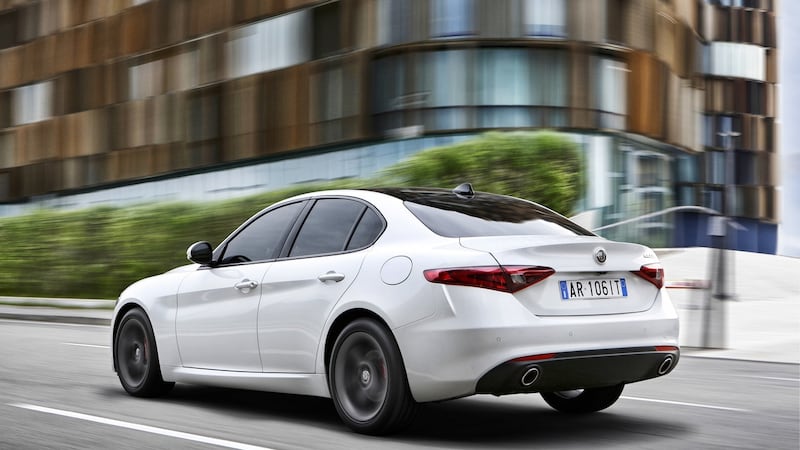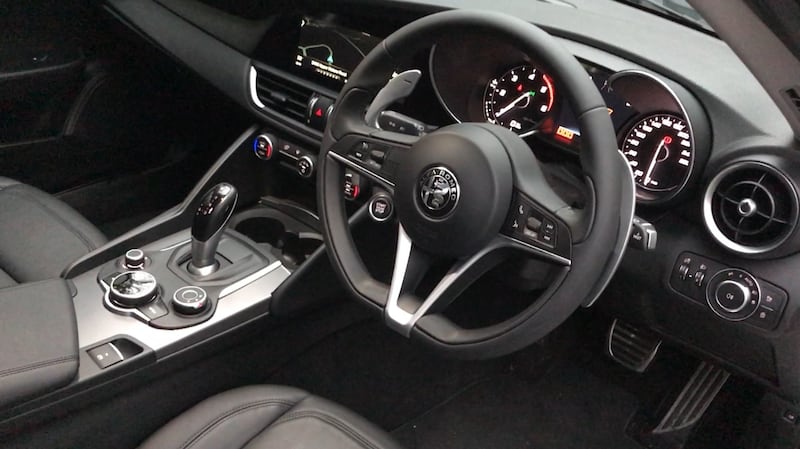At this point, I am doubting my judgment ever so slightly, and am perhaps not the man to answer the question of whether or not the new Alfa Romeo Giulia is good enough.
Good enough to go toe-to-toe with the BMW 3 Series and Audi A4. Good enough to trigger a revival of Alfa Romeo from about 75,000 annual global sales to more than 400,000. Good enough to make us care again.
The problem here is that some of us, some of me, never stopped caring. Disinclined to remove our extra-misty, heavy-rose-tint spectacles, we still adored Alfa Romeo the brand through all the bad times, bad times largely of the brand’s own making.


A mediocre model range for far too long worked under the cloak of that famous badge and its associations with Juan Manuel Fangio, Mario Andretti, Nino Vaccarella and so many more. That won’t pass muster these days, not when the new Giulia must, if it’s going to succeed, take on the might of the German premium car hegemony and some Japanese and British rivals too.
Right, objectivity hat screwed firmly on I think we can skip to the end and say that the Giulia is at the very, very least class competitive. In terms of placing it in the context of its main rivals, I’d put it slightly behind the Audi A4 and Mercedes C-Class, about on a par with the BMW 3 Series and fractionally ahead of the Lexus IS and Jaguar XE.
Alfa’s decision to switch from from a front-wheel drive set-up to classical rear-wheel drive (with optional four-wheel drive for some models in some markets) was an inspired choice, even if it did add years to an already heavily delayed development schedule (the Giulia’s predecessor, the likeable if ignored 159 departed production in 2011).
Sense of agility
It gives the Giulia an instant feeling of rightness, of oneness with the rest of the cars in the class (Audi excepted) and a sense of agility and driver reward that never goes away. There is a tightness, and an obvious rigidity to the whole structure that pervades the driving experience and that gives you tremendous confidence right from the off.
You won’t be pulling any lurid tail-slides though, in spite of the rear-wheel drive. At least you won’t in this 2.2-litre 180hp diesel model. In spite of a very healthy 450Nm of torque, the rear wheels track resolutely with the fronts. In fairness, not many company car drivers (still the primary target market) truly fancy themselves as modern-day Pentti Airikkala, and the benefit is there in terms of both the overall balance and the fact that the Giulia sits rock solid even on wet, slippery surfaces. It’s hugely confidence inspiring.
A shame that the steering isn’t better. It’s very fast-geared across its locks, and imbues the Giulia with great agility, but that speed also means it’s a bit hyperactive and you need to recalibrate your own inputs to suit. It also turns the wheels so far, when manoeuvring at low speeds, that it actually pulls at the tyre treads, which is an odd sensation.
Some of that is made up for by the steering wheel itself, a three-spoke affair with the storied Alfa logo front and centre in a sombre black-and-dark-chrome style. It looks and feels terrific, and as your first point of contact with the car that’s hugely important. The Ferrari-style siting of the engine start button hanging off a steering wheel spoke is a nice touch too, and the rest of the upper dashboard from the big, clear instruments to the long sweep of the dash top to those round 1960s-style air vents is just lovely, and everything is well-assembled from very high quality materials.
Well, almost everything. Drop your left hand down to the infotainment controller and, while it’s been designed to mimic Audi’s MMI system, the push, turn, click wheel feels dreadfully cheap, like something off a late-1990s Daewoo.
There are some other quality issues too, including dreadfully cheap-feeling door bins and some slightly iffy panel fit on the outside.
Feel fantastic
For the most part though, the Giulia looks to have moved past Alfa’s old reputation for questionable quality and during our time with the car there was nary a rattle nor a squeak in the cabin, nor any issue with any system not functioning correctly.
In fact, the Alfa has one small but lovely quality detail that all its rivals lack – the paddles which allow you to take control of the standard-fit eight-speed automatic gearbox are made from solid aluminium, and both look and feel fantastic. They make a mockery of most rivals’ cheap and nasty plastic gearshift pulls.
The engine that they control is mostly good. It gurgles and rattles at low speeds and temperatures, so it’s behind the Audi A4 for refinement, but about on a par with the Mercedes, BMW and Jaguar (and all are well behind the hybrid-only Lexus).
Power is decent and so is performance. The Giulia never feels all that fast (although throttle response is better in the Dynamic setting of the DNA adaptable driving experience) but a 7.1sec 0-100km/h time is fine and Co2 emissions of just 109g/km are impressive. Less impressive is the fuel consumption. Alfa claims 4.2 litres per 100km, which is 67mpg. We could get no better than 6.8l/100km (a paltry 41mpg) which is simply not good enough.
The Giulia as a whole is good enough, though. At least I think it is. I know my mind is clouded and my heart strings tugged by the memory of my grandmother’s white Alfasud which she had when I was but five years old (quite the supercar by early 1980s west Cork standards . . .) and like many enthusiasts, I’ve made excuses for Alfa in the past.
Character. Passion. Excitement. Styling. There’s no doubting that the Giulia has enticing looks, nor that the €43,966 being asked for this well-equipped Super Sport model (a limited, introductory price) is exceptionally good value.
No doubt either that on a technical or quality level, Alfa seems to have stepped well and truly up to the plate and planted the Giulia right in the heart of the highly competitive compact executive class.
The real question now is whether enough people care enough to buy enough.
The lowdown
Alfa Romeo Giulia 2.2JTD 180hp Super Sport.
Price: as tested, €43,966. Range starts at €39,995.
Power: 180hp. Torque: 450Nm. 0-100km/h: 7.2sec.
Top speed: 229km/h.
Claimed fuel economy: 67.3mpg (4.2-l/100km).
CO2 emissions: 109g/km.
Motor tax: €190 per annum.
Verdict: Gorgeous and capable, the Giulia punches hard to make it worthy of comparison with rivals. Will sufficient buyers be swayed, though?












